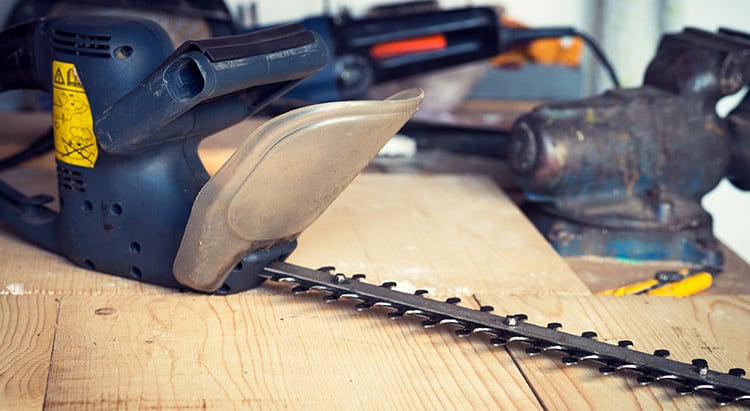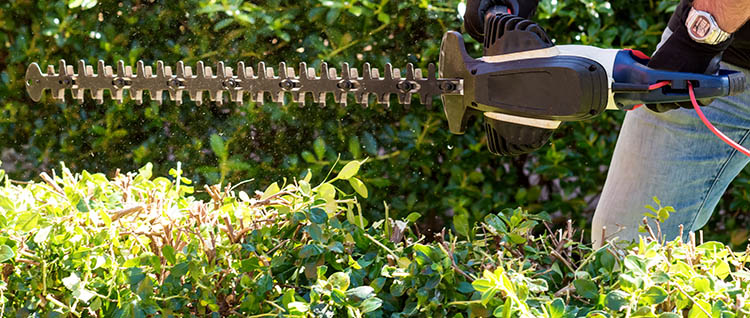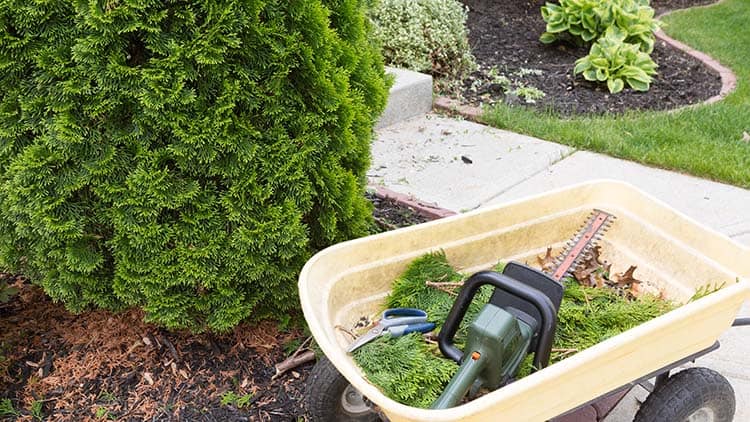Yard maintenance is a big part of making your home look as nice as can be. One of the most common forms of this type of maintenance is cutting bushes and tree branches down with electric hedge trimmers.
However, as with all electrically-powered machinery, hedge trimmers might have their fair share of functional issues. So, what do you do when your hedge trimmer will not start or is not working properly?
If your hedge trimmer doesn’t start, stick around. I’ll explore seven possible causes of why your hedge trimmer won’t start, as well as solutions. Additionally, I’ll discuss a few things to help you prevent these issues from occurring, which will keep your hedge trimmer running for years to come.
7 Reasons Why Your Hedge Trimmer Won’t Start

There are a number of reasons why you may have problems with ensuring that your electric hedge trimmer works properly. Most are easy fixes and should not require extreme maintenance.
Usually, the problem with a faulty electric hedge trimmer is a simple fix. It might be something as minor as a jam in the blades or a loose connection to an electrical outlet.
In small cases like these, your problem can be an easy fix. However, perhaps the problem is bigger than this. Either way, there are steps to follow to get your hedge trimmer working correctly. When followed correctly, you can ensure the longest life for your electric hedge trimmer.
There’s a Loose Connection
If you are using an extension cord to power your electric hedge trimmer, you are going to want to ensure that the cord is securely connected to your hedge trimmer. If it is not fit correctly, you may have trouble getting that initial burst of power.
Another problem with the connection of your cord might happen during your yard work process. You might stray too far from the outlet, which would result in the extension cord unplugging either from your hedge trimmer or the outlet itself.
How to Fix it
Thankfully, this problem can be easily fixed, without much time or effort, and without spending extra money.
Perhaps you have plenty of slack in your extension cord, but the plugin connection with your hedge trimmer seems to be loose or not secure from the weight of the cord hanging down from the hedge trimmer. Many electric hedge trimmers have a built-in cord holder that you can use to take the weight off of the actual plugin.

Even if you do not have that cord holder, it is common to wrap your cord through the back handle of your hedge trimmer a couple of times and then plug the extension cord into your hedge trimmer. This will more tightly secure this cord to your trimmer.
Many problems that result in your hedge trimmer not starting might be the cause of a simple connection issue. If your electric hedge trimmer is not starting, this should be one of the first things you should check. It is an easy fix and should not cause any stress.
Your trimmer has an Older or Dead Battery
Maybe you have chosen to go with a battery-powered hedge trimmer over one that requires an extension cord. Some people prefer this choice because you do not have to worry about getting tangled up with a cord or not having a long enough cord to trim where you need to.
However, you go to start your hedge trimmer, but to no avail? Why is this? Well, the first thing to do is make sure your battery is plugged in all the way. Like an extension cord, if your battery is not securely fastened into your hedge trimmer, it is probably not going to start.
The battery socket for your hedge trimmer typically makes a clicking noise when you plug your battery in all the way, so it should be an easy problem to fix. Another major issue that might restrict your hedge trimmer from starting is a dead battery.
How to Fix it
The batteries of battery-powered hedge trimmers usually last for a sufficient amount of time, but it is important to note when your battery needs charging.
It is a good idea to fully recharge your hedge trimmer battery after every time you use it. That way, you will not have to worry about a dead or low battery bothering you next time you need to use your hedge trimmer.
When charging your battery, the charging dock will have lights that indicate how much life your battery has, and it will also let you know when your battery is fully charged, usually with a solid green light.
Debris is Stuck in the Blade
Reasons for why your electric hedge trimmer will not start do not always have to do with the power source. Maybe your motor even sounds functional, but your blades are not oscillating properly. A common reason for this might be because there is debris such as dirt, leaves, or bits of branches that are stuck in some part of your blades.
How to Fix it
Before using your hedge trimmer, it is a good idea to inspect the blades and ensure that nothing is caught in them that might prevent them from working properly. Even the smallest piece of the branch can get in the way.
If you do find that there is debris in your blades before you do anything else, make sure your hedge trimmer is unplugged from its power source. When you are getting the debris out, you definitely do not want to accidentally turn on your hedge trimmer and end up in a more difficult situation.
After making sure your hedge trimmer is not going to turn on in any circumstance, find where the debris is in your blades. It might be as simple as carefully picking it out with your hands, but maybe it is stuck in between two blades pretty securely. If this is the case, it might not be the best idea to stick your fingers in between those sharp blades.
In this instance, you might consider getting some type of tool that can pry the debris out, whether it be pruning shears, pliers, scissors, a knife, or whatever you find most suitable. Whichever you choose, be especially careful not to damage your blades in the process, as this could lead to even more trouble.
One of the best ways to help keep debris out of your hedge trimmer’s blades is by lubricating the blades before and after use. This will help your hedge trimmer provide a smoother cut and not get caught on anything.
You should also remember that a hedge trimmer is not meant for large branches. Trying to cut a tree or hedge too large can also result in your blade getting damaged or large pieces of debris jamming themselves between your blades.
Your Hedge Trimmer is Overused
While electric hedge trimmers are most definitely more convenient and less exhausting than manual hedge trimming, they also have their limits.
If you spend a few hours trimming hedges, trees, and bushes in your yard, you might take a short break, only to return to work and find that your hedge trimmer will not start.
Overuse of an electric hedge trimmer can cause overheating inside of the hedge trimmer’s motor. If you have checked your power source connection, blade condition, and everything else on the outside of your hedge trimmer, your problem might be internal.
How to Fix it

This is by far the easiest problem to solve, out of all the reasons for your electric trimmer not starting. Simply put your trimmer down, and give it a break. As long as it’s just an overused and over heated trimmer, it should be back in action after it’s cooled down.
One way to tell if your hedge trimmer is overheated is if you see a grey or white smoke coming from within the motor. This does not mean your hedge trimmer is going to explode, but it is surely something you need to check out.
Lack of maintenance, proper lubrication with oil, and overuse are all problems that might cause overheating inside your hedge trimmer’s motor. The build-up of intense friction inside the motor can cause minor problems or even result in your hedge trimmer not starting altogether.
If you think your hedge trimmer is likely overused or overheated from too much trimming in one day or one weekend, this can be an easy fix. Just give it a break. Like you, your hedge trimmer can get overloaded with an overwhelming amount of work. It might just need to cool down for a while.
If you are not sure that your hedge trimmer is not turning on just because it has been powered on for a long period of time, your hedge trimmer might have reached the end of its functionality. If you have used it regularly over a number of years, its parts have likely worn down due to such occasional use.
Even if you take the most in-depth care of your hedge trimmer, it will eventually reach its endpoint. In this case, there is likely not anything you can do except investing in another hedge trimmer.
The Buttons Aren’t Pushed Down All the Way
This might not be the most common reason why an electric hedge trimmer will not start, but it could be a possibility. As I said before, on each handle of your hedge trimmer is a button you must hold down while using your hedge trimmer.
Both hands need to be holding down the button on the handle, which they are grabbing. If your electric hedge trimmer does not start, it might be because you are not pushing hard enough on these buttons.
Of course, not every single hedge trimmer you are going to find will have two buttons: some just have a button on the back handle. Either way, this problem can still occur.
How to Fix it
Sure, it seems silly that this could be a potential problem, but if you cannot determine any other reason why your hedge trimmer is not starting, this might be something to check out.
Especially with the vibrations of the oscillating blades during trimming, it can be difficult to keep your grip on the handles when using such a high-powered piece of machinery.
If you find yourself struggling to keep your hands in place on your electric hedge trimmer, you should consider using yard gloves with an extensive grip on the palms and fingers.
This can better your grip strength on the handles of your trimmer, which will result in the ability to better hold down the power buttons.
Safety Switch is Still Engaged
If you are sure you are holding tight enough, but your hedge trimmer is still not working, check the safety switch. Most electric hedge trimmers have a safety switch to ensure the hedge trimmer will not turn on by accident.
How to Fix it
If this is the problem, the fix is as simple as switching the safety slot to off. Though this can be an easy fix, it is important to recognize that the safety switch is there for a reason.
Especially when you are transporting your hedge trimmer or working in its maintenance, the safety switch is ideal in keeping you and your surroundings safe. Just make sure that when you want to turn your hedge trimmer on, the safety switch is turned off.
Blown Fuse To Power Source or Tripped Circuit
A few other problems might result from your electrical connection. It’s worth double-checking the power source and circuits just to be on the safe side, and to avoid any further issues.
Blown Fuse to Power Source
There might be an electrical problem with the power source of your electricity. Take a look at your main electric box and determine if it seems like a fuse is out. If you do not know how to fix this problem, calling a professional electrician might be your best bet.
Tripped Circuit
The specific circuit breaker that is powering the outlet your cord is connected to might be tripped. This is usually an easy fix. You just have to restart the circuit breaker by flipping the switch off and back on. If this does not work, an electrician might be the path to take again.
How to Keep Your Trimmer Running
A well-maintained trimmer will have fewer issues, and in turn, be more dependable. Taking care of your trimmer with a routine will reduce the risk of problems popping up. Not to mention, while you’re performing these simple maintenance tasks, you’ll be able to check out any possible issues that could be brewing.
Understanding Your Trimmer
To fully take care of your trimmer, and make it last, it’s important to understand how it works. Whether your electric hedge trimmer is battery-powered or requires an extension cord plugin, they function in a similar way.
Before you begin hedge trimming, it is recommended to put a small amount of lubricant on the blades of your trimmer.
This will ensure smooth oscillation during your cutting. It is also a good idea to do such after use of your hedge trimmer while you are cleaning it out.
When your power source is connected to your hedge trimmer, and you are ready to go, you should then flip any on switches necessary and turn off any safety switches. Usually, your hedge trimmer will have two buttons on each part where your hands go.
Holding both of these buttons down will result in the blades of your hedge trimmer beginning to oscillate back and forth. For your hedge trimmer to function properly, the button or buttons on the handles must be held down at all times.
Keep in mind that hedge trimmers – particularly electric hedge trimmers – are not meant to cut down thick tree branches or trees themselves. They are meant for, well, trimming hedges, and perhaps cutting the occasional thin branches off of trees.
You were pushing your hedge trimmer in an attempt to cut a branch thickness larger than an inch can result in damage.
We have already covered a few ways to properly take care of your hedge trimmer, and there are not a huge amount of other ways, but maintenance is important for getting the most out of your electric hedge trimmer.
Routine Maintenance
There are some things that you can do at home to properly maintain your hedge trimmer. Below are some basic maintenance tasks that you can do on your own. These will help make sure your trimmer starts for you when you need it.
Blades
Keeping track of the condition of your blades should be a top priority for hedge trimmer maintenance. Always check for debris that could be stuck in your blades prior to your next use.
Also, pay close attention to any damage to your blades. If any of your blades are bent or broken, this can mess up the entire hedge trimming process and further threatens the risk of a dysfunctional hedge trimmer.
Check out this short video to see how to clean your trimmer blades properly so that they will last as long as possible:
Power Source
Whether your electric hedge trimmer is battery-powered or requires an extension cord, make sure your power source is functioning properly. You do not want a damaged battery to further impair your hedge trimmer.
On the other hand, you do not want a faulty extension cord to disrupt the functionality of your hedge trimmer.
Before use, always make sure either your battery is fully charged and in working condition or that your extension cord is long enough and properly connected to both an electrical outlet and your hedge trimmer.
Motor
Recognizing any problems with the motor inside your electric hedge trimmer is key. If you ever see smoke or hear something unusual inside your motor, it is probably because you have not taken care of your hedge trimmer as well as you should have.
Regular evaluation can be taken regarding the condition of your hedge trimmer’s motor. You do not have to know about all things electric and motor. Lookup and research how to take apart the protective covering over the motor and how to examine its different parts.
Limits
Do not push your hedge trimmer farther than it can go. It will say in the owner’s manual how long it can last, how thick of a branch it can cut, and more.
Disregarding these precautions can and likely will result in severe damage to your hedge trimmer or yourself.
If you do put forth an effort to maintain even the smallest aspects of owning an electric hedge trimmer, you may not reap the entire benefits of its maximum life.
Some of My Top Electric Hedge Trimmer Picks
If your electric hedge trimmer is an older model, it’s quite possible that you might just need a new one. Also, a new hedge trimmer will have fewer issues than an old one. There are many electric hedge trimmer out there to choose from, but below I have provided some popular and reliable products that you can easily get on Amazon.
The WORKPRO 20V Cordless Hedge Trimmer from Amazon has been reviewed as a great product by many of its owners. One satisfied customer even claims they had used this product for fifteen years with no problems. At around five pounds, this battery-powered hedge trimmer can be used for quick and efficient work.
Black + Decker Hedge Trimmers are very popular. Many of their products are bestsellers, and their reviews speak for themselves. The lightweight design of this electric hedge trimmer also comes with a cord retention clip to prevent connection problems.
The CRAFSTMAN Electric Hedge Trimmer on Amazon, like all CRAFTSMAN products, is a very popular name among outdoor machinery. While many electric hedge trimmers suggest not even attempting to cut through over an inch of branches, CRAFSTMAN claims that their product can cut up to one and a half inches.
These are just a few of the many electric hedge trimmers you can find online or in hardware stores. If you do not already have an electric hedge trimmer but are looking into it, these products are a good place to start. Although, what you choose in the end will come down to your personal preference.
Takeaway
There are a number of reasons why your electric hedge trimmer might not be starting. Fortunately, most of these problems can be solved with simple at-home remedies.
Additionally, most of these problems can be completely prevented with extensive maintenance and care before using your electric hedge trimmer.
Electric hedge trimmers are becoming very popular because of their efficiency both in providing you an easier workday and providing the environment around you with less noise and pollution.
Also, their prices are often much more reasonable than those of gas-powered hedge trimmers. These lightweight hedge trimmers are the talk of the town.
The way in which an electric hedge trimmer works is simple, and when you take proper care of your hedge trimmer, you should have less of a chance of facing common problems that might occur.
As with all types of machinery, along with regular maintenance, it is important to take into account how often you use your electric hedge trimmer, especially in just one day.
Overuse can cause major problems with your hedge trimmer, including overheating and other internal issues.
I hope this article was helpful for you if you are having trouble figuring out what might be wrong with your hedge trimmer. Most of the problems that may arise are typically minor setbacks that can be fixed with care and attention.

